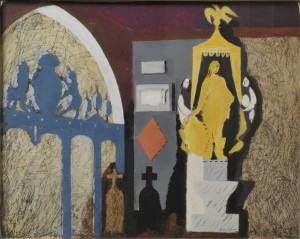Looking at Lydiard Park's beautiful grounds and playing fields today it is hard to imagine they were once occupied by a German military hospital camp. Yet a complex of tents, Nissan huts and one or two concrete and brick buildings occupied some eighty acres of the park during World War II and its aftermath. There is virtually no evidence of the camp left on the ground but documentary material brings this memorable part of Lydiard’s history to life.
Our special collection draws together photographs of the German doctors, nurses and patients as well as British military personnel of 160 Hospital Camp Lydiard Park. Original plans of the camp, a roll call of prisoners, artwork and personal testimonies throw light on the lives of men and women from both sides of the conflict. There are stories of mutual respect and friendship that grew up between prisoners and local families as well as British and German officers. Camp interpreter John Bailey wrote movingly:
‘ slowly it began to dawn on me that these were ordinary people – human beings with feelings and troubles the same as myself.’
Originally established as an American hospital camp the facility comprised twelve ward huts connected by corrugated covered walkways to protect patients from the elements as well as larger huts which were used for kitchens, mess huts, stores, a chapel and a mortuary.
The camp was designated as a Prisoner of War Hospital in August 1944, though it still retained a small percentage of US patients. In that month alone 49 major operations and 664 minor operations were conducted, as well as 529 outpatient visits and 676 consultations. German nurses had started to arrive and eighty POW’s who had recovered their health were kept on to assist around the camp, their roles ranging from “trash detail” to stretcher bearers and general site maintenance.
Security in the camp tightened in October 1944 with the construction of watch towers at various corners of the hospital perimeter and a barbed wire fence around the wards and clinics. The New Year saw the hospital being turned over to German Protected Personnel under American supervision. Twenty one German doctors arrived in March.
After the end of World War II the hospital camp was retained and operated under British supervision. War casualties continued to be treated by German doctors and nursing staff led by Professor Werner Waschsmuth, Camp Commandant and Senior Surgeon (March 1945 - April 1946) whose remarkable story of defying Hitler and saving the lives of hundreds of injured soldiers and civilians is one of our featured items.
POW’s who were well enough worked on local farms and while on the camp relieved their boredom in craft work, writing and painting. Peter Probst, a 36 year old German serviceman, began his interment at Lydiard in 1947 and discovered a talent for painting. You can see some of his paintings in this collection and discover how he and Professor Waschsmuth both tried to find Lydiard Park years after they were repatriated to Germany.
160 POW Hospital Camp Lydiard Park finally closed in February 1948 and the camp was converted into housing for local people –another chapter in Lydiard’s rich history.















